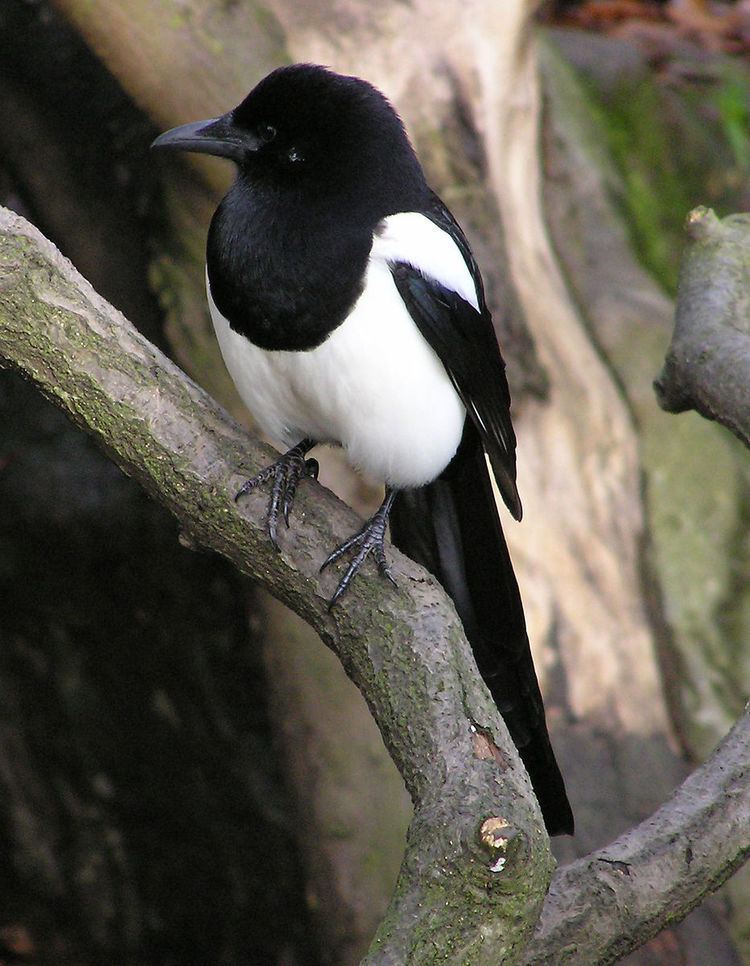Published c. 1780 | ||
 | ||
"One for Sorrow" is a traditional children's nursery rhyme about magpies. According to an old superstition, the number of magpies one sees determines if one will have bad luck. It has a Roud Folk Song Index number of 20096.
Contents
Lyrics
There is considerable variation in the lyrics used. A common modern version follows:
Origins
The rhyme has its origins in superstitions connected with magpies, considered a bird of ill omen in some cultures, and in Britain, at least as far back as the early sixteenth century. The rhyme was first recorded around 1780 in a note in John Brand's Observations on Popular Antiquities on Lincolnshire with the lyric:
One of the earliest versions to extend this was published, with variations, in Michael Aislabie Denham's Proverbs and Popular Saying of the Seasons (London, 1846)
On occasion, jackdaws, crows, and other Corvidae are associated with the rhyme, particularly in America where magpies are less common.
In popular culture
A version of the rhyme became familiar to many UK children when it became the theme tune of an ITV children's TV show called Magpie, which ran from 1968 to 1980. The popularity of this version is thought to have displaced the many regional versions that had previously existed.
In the Counting Crows song "A Murder of One", the lyrics contain a modified version of the rhyme. The rhyme is also the origin of the group's name.
Also mentioned in book four of The Mortal Instruments, City of Fallen Angels, by Cassandra Clare. The character Simon reflects on his mother teaching him the rhyme as a child.
It was recited in the popular Canadian television show, Lost Girl, when the protagonist, Bo, searched for The Wanderer.
A quest in The Secret World uses lyrics from this poem in one of its puzzles, involving ravens.
Ashe Corven recites a version of the rhyme in the 1996 film The Crow: City of Angels, with crows in place of magpies.
The rhyme is in part 5 of Monday, January 12 in the mystery Through the Evil Days by Julia Spencer-Fleming when a crow caws once in a tense winter scene, leaving a character who is visualizing a grim outcome to hope for a second caw.
The novels in the John, the Lord Chamberlain series of Historical mysteries, taking place in Justinian's Constantinople, all have titles derived from the nursery rime, the first one (published in 1999) being named "One for Sorrow". The belief that the number of magpies one sees give an indication of one's future is attributed to a knight of King Arthur's Round Table visiting Constantinople in the first volume - which might be an anachronism.
The Finnish melodic death metal band Insomnium also released an album on October 14, 2011 entitled 'One for Sorrow' containing tracks such as "Song of the Blackest Bird" and "One for Sorrow". The album art also depicts silhouettes of birds in flight soaring through a dimly lit sky and the earlier version of the rhyme was also used on the back of their "One for Sorrow" hooded sweatshirt.
In the 2015 season premiere episode of Sleepy Hollow, the character Pandora recites this rhyme while conjuring up images of recently slain victims.
British folk group The Unthanks include the song Magpie on their 2015 album, the lyrics of which contain portions of this rhyme.
In the Netflix show Hemlock Grove it was recited to children in a library.
The opening two-part episode of the 2015 season of (Inspector) Lewis was titled "One for Sorrow", and involved a stuffed magpie.
Two versions of the rhyme play an important part in Terry Pratchett's novel Carpe Jugulum (1998), where magpies are considered the eyes of the cunning vampire Count Magpyr.
The lyrics to this poem can be found in the artwork, A Flock of Words in Morecambe, amongst other poems about birds.
Lyrics from the rhyme are mentioned in Corinne Bailey Rae's song "Choux Pastry Heart", from her self-titled debut album, released in 2006.
